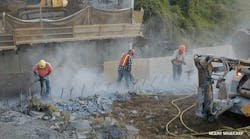A key component in preventing overexposure to silica and subsequent disease is to have at least one individual on the job site who is capable of recognizing and evaluating situations where overexposure may be occurring; who knows how to evaluate the exposure potential; and who can make an initial recommendation on how to control that exposure. This is the role of the “silica-competent person.”
The American Industrial Hygiene Association (AIHA) has released the white paper, “Recommended Skills and Capabilities for Silica Competent Persons,” http://www.aiha.org/newspubs/govtaffairs/Pages/PositionStatements.aspx which represents a common, minimum body of knowledge needed by a competent person to provide meaningful worker protection from silica. The document was prepared by the AIHA Construction Committee Silica Competent Person Project Team.
The hazards of excessive exposure to crystalline silica have been known since ancient times, going back to the construction of the pyramids. However, despite more than 2,000 years of knowledge that silica is a hazard, data from the National Occupational Respiratory Mortality System indicates that between 1990 and 1999 there were still 118 reported silica-related deaths in the construction industry.
The construction industry is dominated by small- and medium-sized employers. Over 80 percent of construction establishments have 10 or fewer employees, according to The Construction Chart Book, published by the Center for Construction Research and Training. Many small- and medium-sized employers do not have safety or industrial hygiene staff.
An approach used by OSHA and ANSI for construction regulations and guidance is to specify that an employer designate a “competent person” for hazards involving medium to high complexity. OSHA’s Advisory Committee for Construction Safety and Health (ACCSH) has recommended that OSHA utilize a competent person approach for the upcoming proposed silica in construction rule. In addition, the National Occupational Research Agenda (NORA) construction goals for silica identified competent person training needs as an area for partnering and development.
According to the white paper, silica-qualified person:
- Has a recognized degree, certificate, or professional standing in an occupational health, safety, environmental, or engineering field (e.g., CIH, CSP, PE);
- Has extensive knowledge, training, and experience in hazards and control of silica hazards on the construction site through formal training and/or extensive, firsthand experience in anticipation, recognition, evaluation, and control of worker silica exposure; and
- Can make quantitative assessments of worker exposure and recommend detailed control measures.
The person also should be able to identify silica, understand the hazards and routes of exposure, be able to determine if silica is present and is knowledgeable about published exposure level ranges for common construction jobs and understand the controls used to minimize the risk of worker exposure to silica.
